In the northeastern corner of Indonesia, the Lembeh Strait welcomes divers into a new world where critters are the main attraction. These rare, small, and often astonishingly camouflaged marine animals are the reason this region is known as the Critter Capital of the World.
While other destinations boast coral walls and pelagic marine life, Lembeh offers something far more curious. Here, the magic lies in the details. On these dark slopes, divers slow down and learn to look closely. Frogfish, pipefish, and seahorses blend into the rubble so well that finding one feels like uncovering a secret.
But what makes these critters so special, and why does Lembeh continue to lure the world’s most seasoned divers? Let’s take a closer look at the life that hides in the sand!
What Is a “Critter” in the Context of Diving?
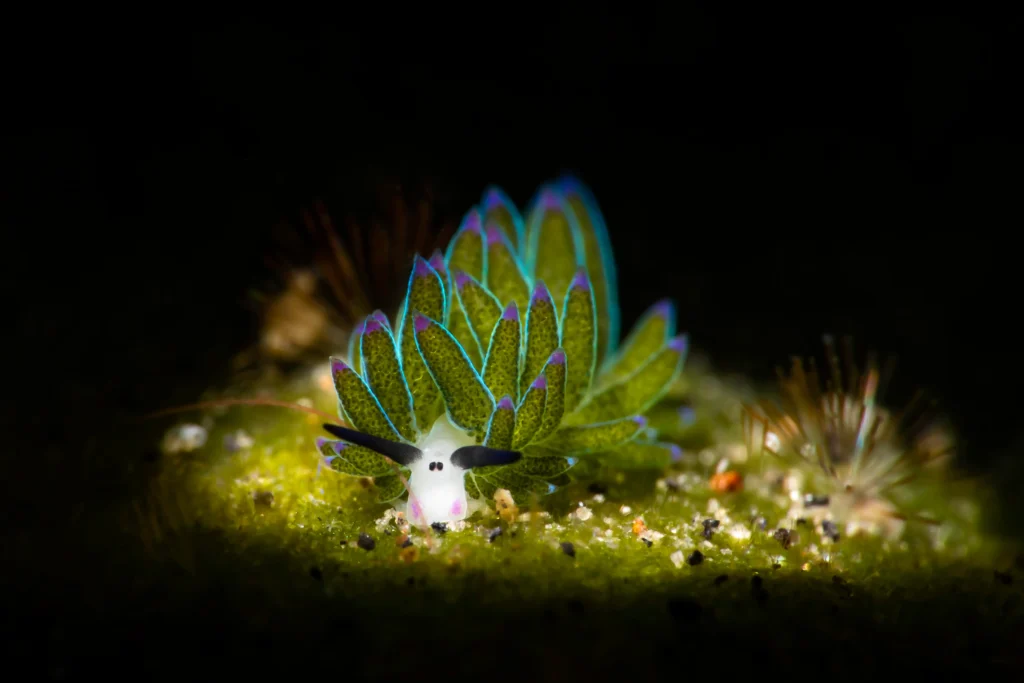
A critter is a small, often unique marine animal that lives on the seafloor. In diving, the term is used for rare and hard-to-find species that many people overlook. These animals rely on camouflage, size, or unusual behavior to survive.
Some of these “critters” include nudibranchs with bright patterns, pygmy seahorses the size of a grain of rice, frogfish that walk on their fins, and octopuses that can change shape and color in seconds. They may be tiny, but they’re full of character.
Though small, they’re especially popular with underwater photographers for their distinct shapes, striking colors, and surprising behaviors. Capturing them may take patience, but the results are often unforgettable!
Why is Lembeh Famous for Muck Diving?
Lembeh is known around the world as the best place for muck diving. This kind of diving happens on the seafloor, not on coral reefs. Instead of bright corals, you explore black volcanic sand, soft silt, and bits of natural debris. It might not look exciting at first, but this is exactly what makes Lembeh special.
The dark sand creates the perfect hiding place for all kinds of unique marine life. Tiny octopuses, rare nudibranchs, camouflaged frogfish, and hundreds of other species live here. They blend in so well that finding them becomes part of the adventure.
For photographers, the dark volcanic sand also acts as a clean, uncluttered background that helps colorful critters stand out in sharp contrast. Each dive feels like a slow-moving treasure hunt, with something unexpected waiting in every grain of the sand.
6 Iconic Critters You Can Spot in Lembeh Strait
From camouflage experts to color-changing cephalopods, the critters of Lembeh offer endless fascination for those who look closely. Below, we’ve gathered some of the standout species divers come here to find:
1. Frogfish
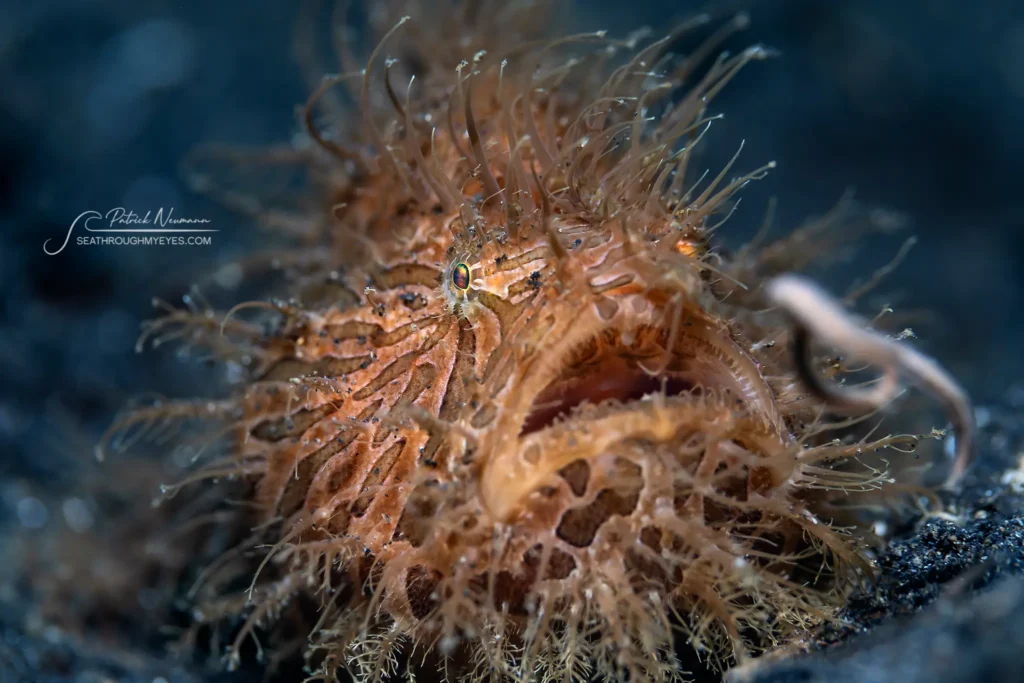
Lembeh is one of the best places in the world to see frogfish. At least eight species are spotted regularly here, each with its unique look and behavior. These ambush predators are experts at blending in, often vanishing into their surroundings with skin textures that mimic sponges, algae, or bits of debris.
Some of the most frequently seen species in Lembeh include:
- Hairy Frogfish (Antennarius striatus)
- Painted Frogfish (Antennarius pictus)
- Warty Frogfish (Antennarius maculatus)
- Giant Frogfish (Antennarius commerson)
- Hispid Frogfish (Antennarius hispidus)
- Randall’s Frogfish (Antennarius randalli)
- Ocellated Frogfish (Antennarius ocellatus)
2. Octopuses
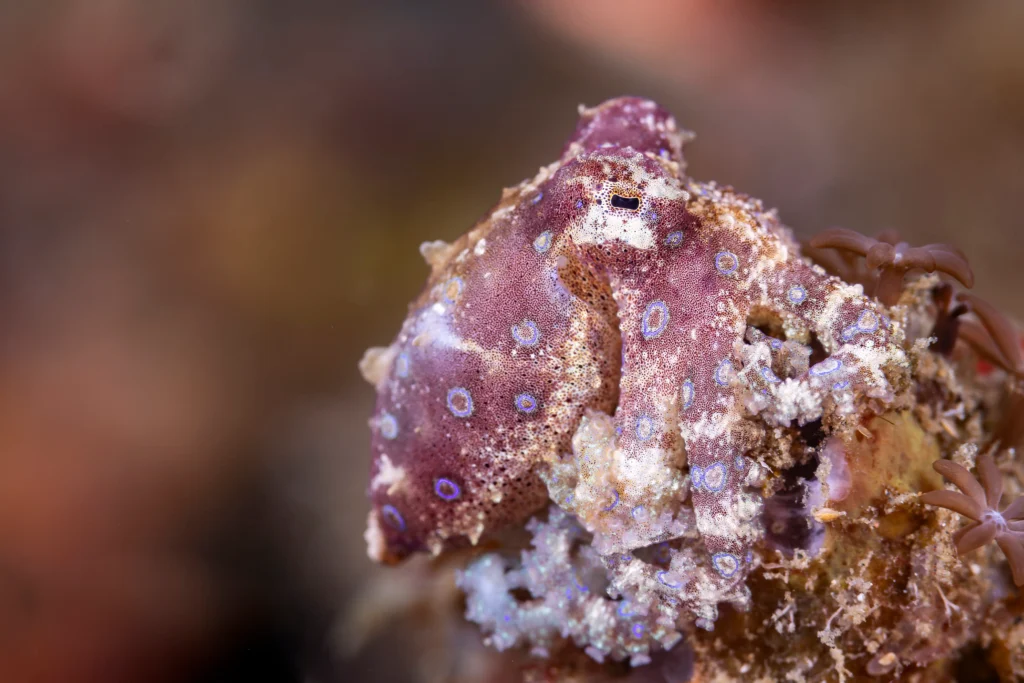
Octopus encounters are one of the highlights of diving in Lembeh Strait. These intelligent, shape-shifting invertebrates bring a sense of drama and surprise to the black sand. With at least a dozen species found in the area, every dive holds the chance to witness something rare and remarkable.
Some of the most iconic octopus species seen in Lembeh include:
- Blue-Ringed Octopus (Hapalochlaena spp.)
- Mimic Octopus (Thaumoctopus mimicus)
- Wunderpus Octopus (Wunderpus photogenicus)
- Coconut Octopus (Amphioctopus marginatus)
- Mototi Octopus (Amphioctopus mototi)
3. Shrimp & Crustaceans
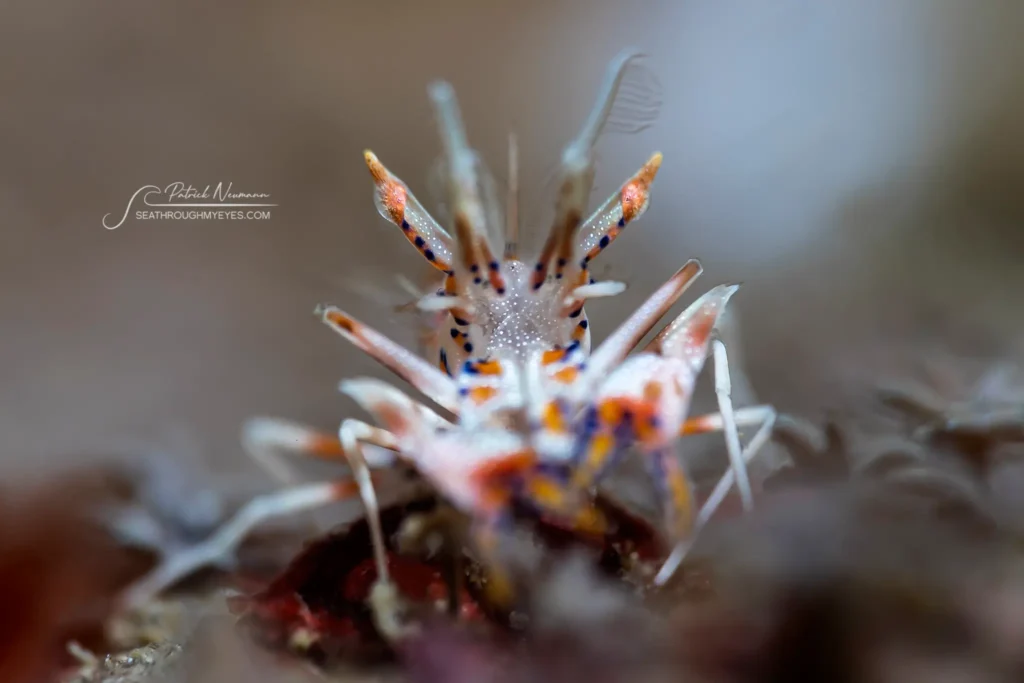
The diversity of crustaceans in Lembeh Strait is nothing short of incredible. On some dives, they seem to outnumber the fish. They offer endless fascination for macro photographers and keen-eyed divers alike.
Some of the most eye-catching and unique crustaceans you can spot in Lembeh include:
- Harlequin Shrimp (Hymenocera picta)
- Coleman Shrimp (Periclimenes colemani)
- Emperor Shrimp (Periclimenes imperator)
- Hairy Shrimp (Phycocaris simulans)
- Spiny Tiger Shrimp (Phyllognathia ceratophthalma)
- Peacock Mantis Shrimp (Odontodactylus scyllarus)
- Boxer Crab (Lybia tessellata)
- Orangutan Crab (Achaeus japonicus)
- Candy Crab (Hoplophrys oatesii)
- Zebra Crab (Zebrida adamsii)
- Hairy Squat Lobster (Lauriea siagiani)
4. Seahorses & Pipefish
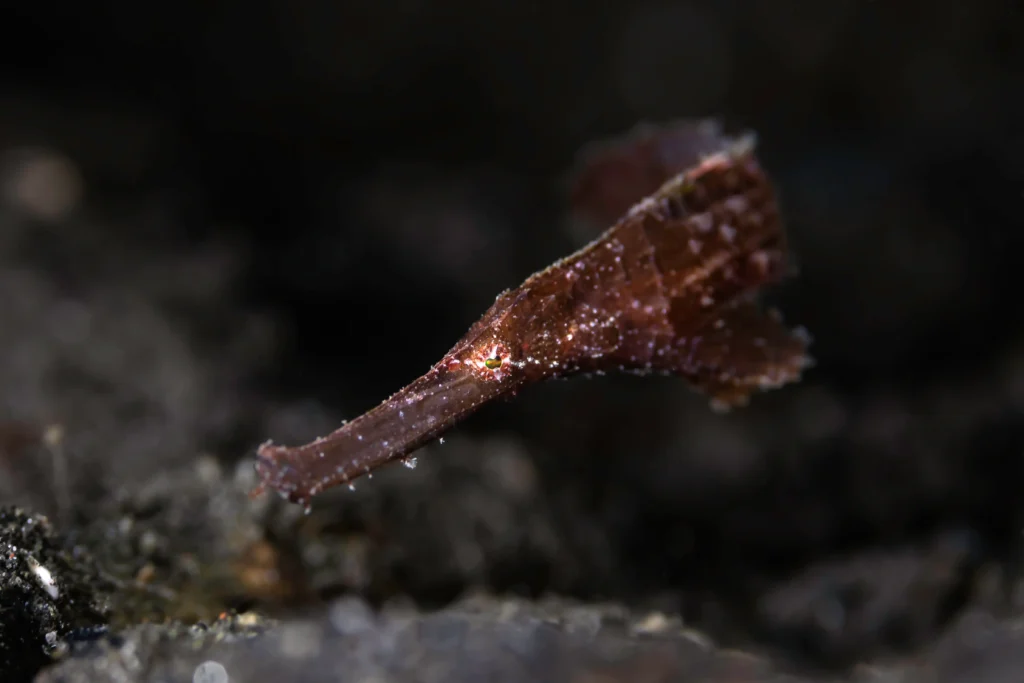
Seahorses hold a special place in Lembeh’s underwater world. These delicate and often elusive creatures are part of the Syngnathidae family, which also includes pipefish and ghost pipefish. Spotting a well-hidden pygmy seahorse tucked into a sea fan is a moment many divers remember for life.
Some of the standout seahorses and pipefish you can find in Lembeh include:
- Bargibanti Pygmy Seahorse (Hippocampus bargibanti)
- Pontoh’s Pygmy Seahorse (Hippocampus pontohi)
- Thorny Seahorse (Hippocampus histrix)
- Ghost Pipefish (Solenostomidae)
- Ornate Ghost Pipefish (Solenostomus paradoxus)
- Halimeda Ghost Pipefish (Solenostomus halimeda)
5. Nudibranchs & Sea Slugs
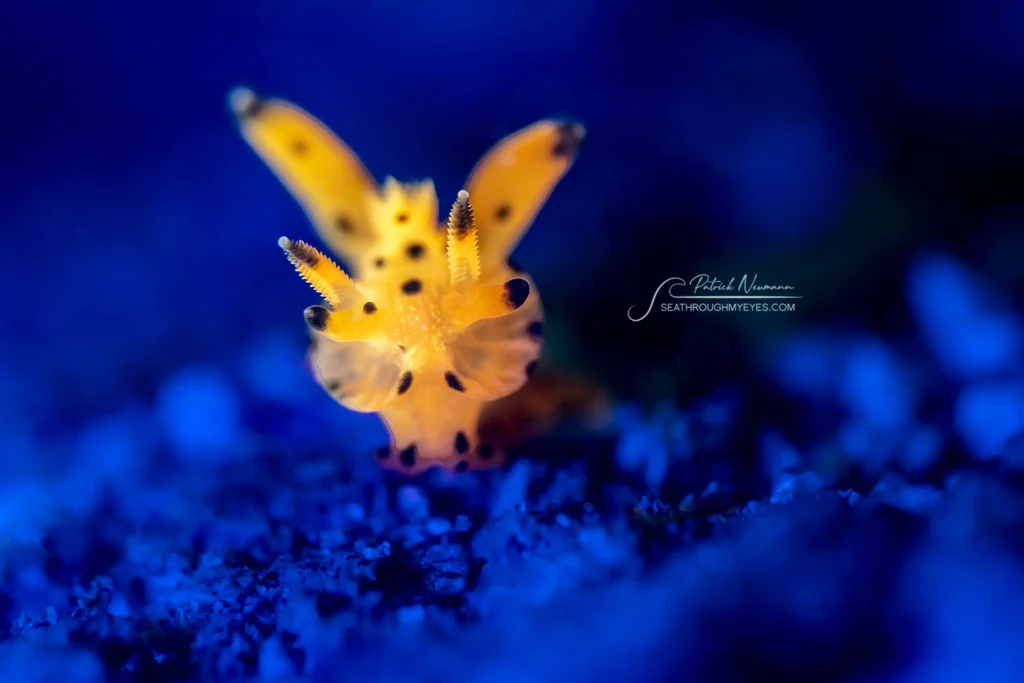
If you’re into sea slugs, Lembeh is a great place to find them. The Strait is home to a wide variety of nudibranchs, known for their bright colors, odd shapes, and interesting behaviors. Some feed on algae and store solar energy, while others use their bold patterns to warn predators.
A few standout nudibranchs commonly seen in Lembeh include:
- “Shaun-the-Sheep” Nudibranch (Costasiella kuroshimae)
- “Pikachu” Nudibranch (Thecacera pacifica)
- Donut Doto Nudibranch (Doto greenamyeri)
- Solar-Powered Nudibranch (Phyllodesmium longicirrum)
6. Extraordinary Cephalopods and Unusual Critters
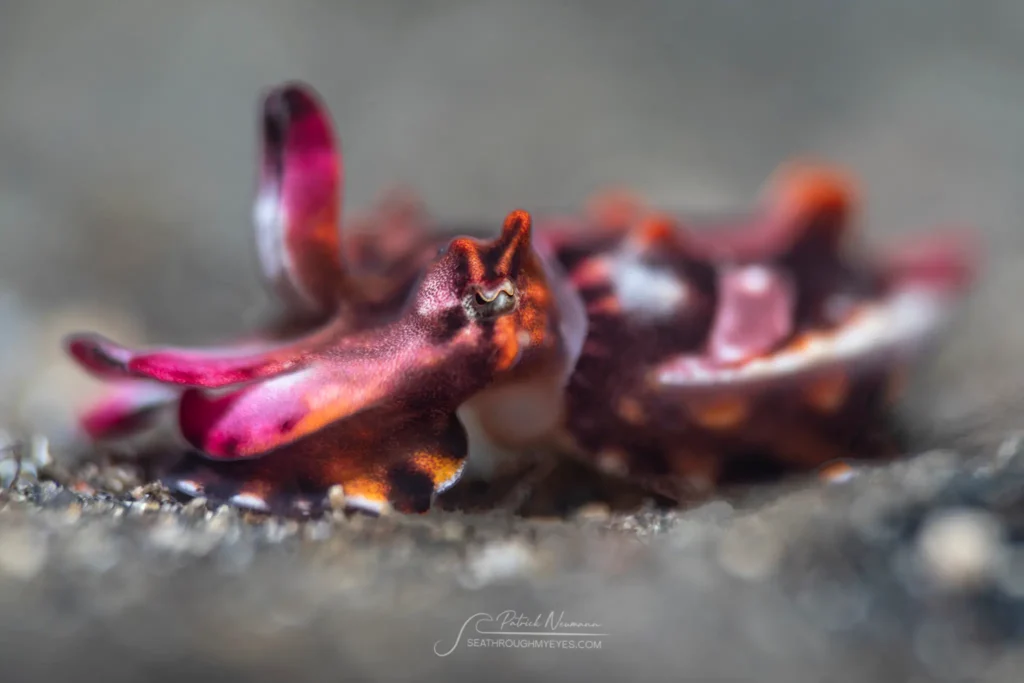
Lembeh’s cephalopods include more than just octopuses. Flamboyant cuttlefish and bobtail squids are also common, known for their bright colors, quick movements, and ability to blend into their surroundings. These species often surprise divers with how suddenly they appear and disappear in the sand.
Notable finds in this group include:
- Flamboyant Cuttlefish (Metasepia pfefferi)
- Pegasus Sea Moth (Eurypegasus draconis)
- Ambon Scorpionfish (Pteroidichthys amboinensis)
- Weedy Scorpionfish / Rhinopias (Rhinopias frondosa)
- Stargazer (Uranoscopus spp.)
- Bobbit Worm (Eunice aphroditois)
Best Time to Dive in Lembeh
While Lembeh offers world-class critter diving year-round, its two distinct seasons bring subtle changes to water conditions and marine life behavior.
Wet Season (November – June)
From November to March, Lembeh’s rainy season brings short showers followed by sunshine. Water temperatures rise to approximately 28°C (82°F), which can cause some critters to move into deeper waters around 30 meters. Westerly winds may create a surge on the Lembeh Island side, so guides often choose the calmer north side of Sulawesi.
This is an excellent time for macro sightings. Mimic Octopus are often observed mating from January to July, while Blue-Ringed Octopus carrying eggs are commonly seen between January and March.
Dry Season (July – October)
From July to October, cooler water temperatures of around 25°C (77°F) make this one of the best times to dive in Lembeh. Many critters prefer these conditions, so they’re easier to find in shallower depths, often above 20 meters. The cooler water also means longer bottom times with less effort, perfect for slow, focused dives.
Most of Lembeh’s signature critters are active during this season. With calm conditions and optimal lighting, this is also a favorite window for underwater photographers aiming to capture Lembeh at its most alive.
How to Prepare for Macro Photography in Lembeh
Macro photography is the go-to style for shooting critters in Lembeh. It focuses on small subjects at close range, making it perfect for the detailed patterns, textures, and camouflage that define life in the Strait. Because many species are small and deliberate in movement, photographers often have time to frame a clean shot.
To get the best results, you’ll want the right gear. A DSLR or mirrorless camera with a dedicated macro lens, usually in the 60mm to 105mm range, is ideal. Compact cameras also perform well when paired with an external wet lens. Lighting is key, so external strobes are highly recommended to bring out true colors and reduce shadows against the dark sand. With patience, control, and attention to detail, Lembeh becomes a playground for photographers looking to create powerful, intimate images of the ocean’s most unique creatures.
Is Lembeh Worth It for Macro and Muck Enthusiasts?
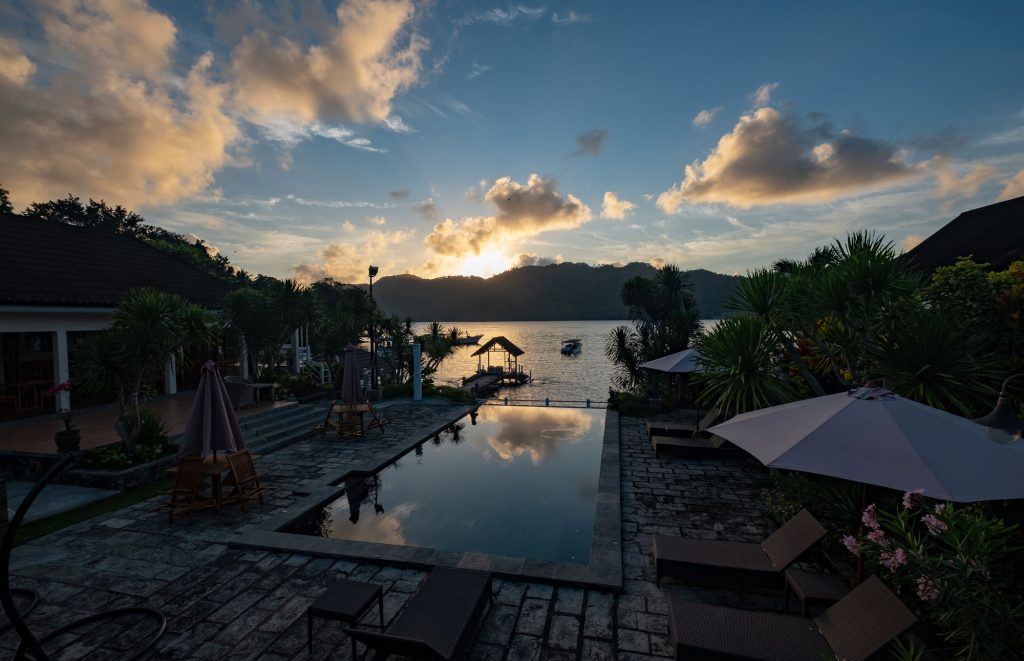
Absolutely. For divers who love the small, the rare, and the wonderfully unique, Lembeh is unmatched. This is a place where your understanding of marine life deepens with every dive. The Lembeh Strait is one of the most rewarding places to experience macro and muck diving, where each site offers something new for patient eyes and steady hands.
To make the most of it, the right environment makes all the difference. You want calm, well-paced diving, guides who know where and how to look, and support that keeps your focus on the water. At Solitude Lembeh, every detail is built around that promise. From expert spotters and private guiding to thoughtful camera facilities and warm, attentive hospitality, the resort offers one of the most complete critter diving experiences anywhere in the world.
Ready to meet Lembeh’s most iconic critters? Book your dive adventure with Solitude Lembeh today!